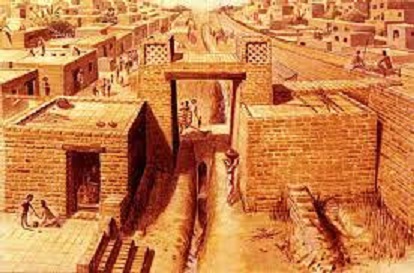
The Harappan Civilization (Chronology And Geographical Distribution)
Last Updated On: 11 December 2021
It is unlikely that civilization efforescence was a simultaneous process in all parts of the Harappan distribution area. By 2600 BCE this civilization was in existence. As it had clear contacts at that point of time with mesopotamia. it appears increasingly probable that it matured first in lower sind, Cholistan and presumably the Kutch region which was linked by arive to the cholistan area. Cities like Harappa, Kalibangan and Banawali came up a little later. The end was also staggered in time. Urban decline at Mohanjodaro had set by 2200 Bc and by 2100 BC it had ceased to exist as a city. However the civilization continued after 2000 BC in other areas and at some sites survived till 1800 BC.
Indus settlements are spread over a wide swathe or stripe of northwest India and Pakistan and their distribution illuminates the various ways in which this varied geographical areas was exploited. In the lower basin of Larkana, Mohenjodaro dominated the flood plain, agriculturally the richest part of sind. Larkana is also marked by lake depressions such as the Manchhar, where fishing settlements existed. Towards the west there were clusters of sites in the foothills of the kirthar mountain range and the kohistan. There agriculture must have depended on spring water and rains. Routes linking up with Baluchistan also passed through this area. In upper Sind the sukkur rorhi hills saw settlements of workmen in and around flint quarries, the raw material from which harappan blades were manufactured. The course of the Indus river in the third millennium BC was more southeasterly and it flowed into the Arabian sea in the vicinity of the Rann OF Kutch. The Indus river adopted its present course only between the tenth and the 3rd centuries AD.
As one moves west, Baluchistan is reached where Harappan settlements are found in a variety of terrain across the northern mountain rim on flat Kacchi plain, in the district of Las Bela towards the south and along the coastal country known as the Makran. In the latter area the fortified sites of sutkangendor and sotka koh were important in terms of the Indus civilization sea trade with the persian gulf and mesopotamia. Both linked up with the interior. In other parts of Baluchistan, Indus sites are found in areasthat are still agriculturally viable and lie on arterial routes. Pathani Damb, for instance, was near the Mula pass, from where a route went across the Kirthar range while Naushahro was in the general vicinity of the Bolan, through which a major route led to Afghanistan. Such routes were important because through them, Baluchistan metalliferrous ores and semi precious stone could be procured by the resource-poor Indus valley. The northernmost site of the Indus civilization, Shortughai, is in northeast Afganistan. Shortughai provided access to Badakshan's lapis lazuli and possibly to the tin and gold resources of Central Asia.
To the northeast of Sindh is the Pakisthan province of Punjab. A large part of the province is comprised of doabs or tracts lying between two rivers. Of these the Bari doab sites are noteworthy, especially the sprawling city of Harappa. There are no settlements in the interfluves of the Jhelum and the Indus or that of the Jhelum and Chenab. South of the Sutlej river, is Bahawalpur. Part of it is made up of the desert trace of Cholistan, through which the Hakra river flowed. The largest cluster of Indus settlements is found here. Geographically, this tract connects the Indus plains with Rajasthan, which has vast copper deposits. There were several exclusive industrial sites in Cholistan marked by kilns, devoted to large scale craft production that included the melting and smelting of copper.
East of the Sutlej is the alluvial terrain of the Indo-Gangetic divide, a transitional area between the Indus and the Ganga river systems, made up of the Indian states of Punjab, Haryana, Delhi and Ghaggar river course in Rajasthan. A large part of the riverine and stream drainage from the Siwalik ridge between the Sutlej and Yumuna used to converge into the Ghaggar, the Indian name for the river known as the Hakra in Pakistan. There were several provincial urban centres in this region such as Kalibangan and Banawali although Rakhigarhi was the largest city and is said to be as large as Harappa. Classic Indus sites are also found in the Yamuna-Ganga doab with preponderance in its most northerly portion around Saharanpur.
Finally, the spread of the Indus civilization included the quadrilateral of roughly 119000 square kilometers between the Rann of kutch and the Gulf of Cambay. Dholavira was the city par excellence of the Rann, with its vast expanse of tidal mud flats and dead creeks. Further east, the great mass of Kathiawad, now known as Saurashtra is formed of Deccan lava and on its eastern edge flourished the port town of Lothal. The mainland of Gujarat is alluvial, formed by the Sabarmati, Mahi and minor parallel stream, actively prograding into the Gulf of Cambay. Here Bhagatrav on the estuary of the kim river, forms the southernmost extention of the Indus civilization.